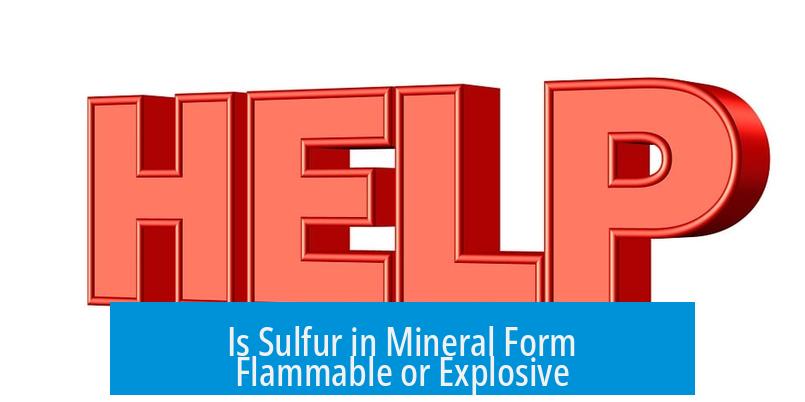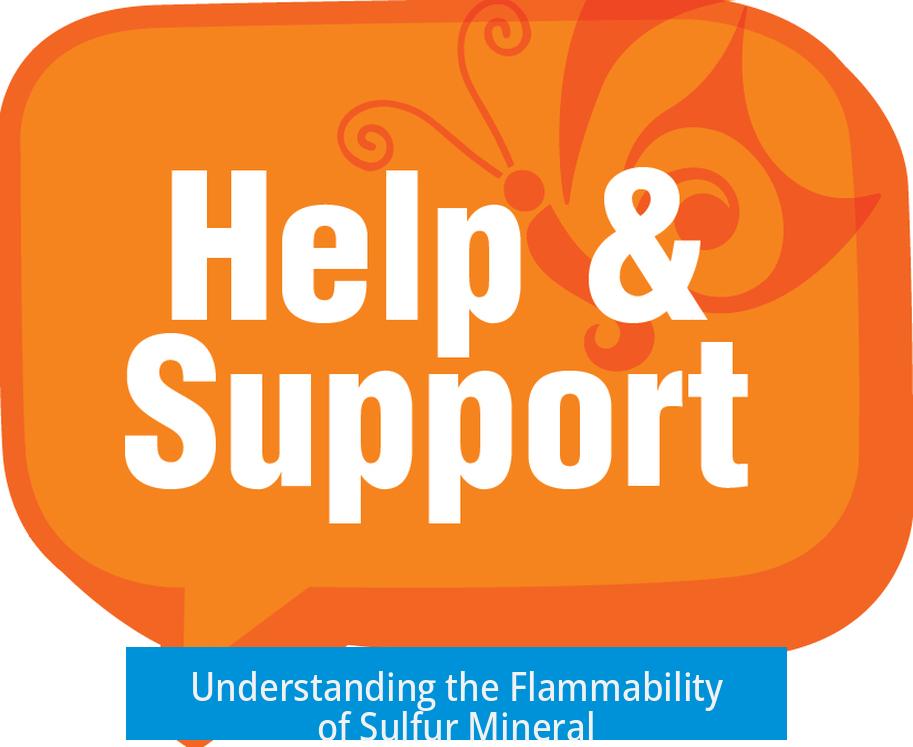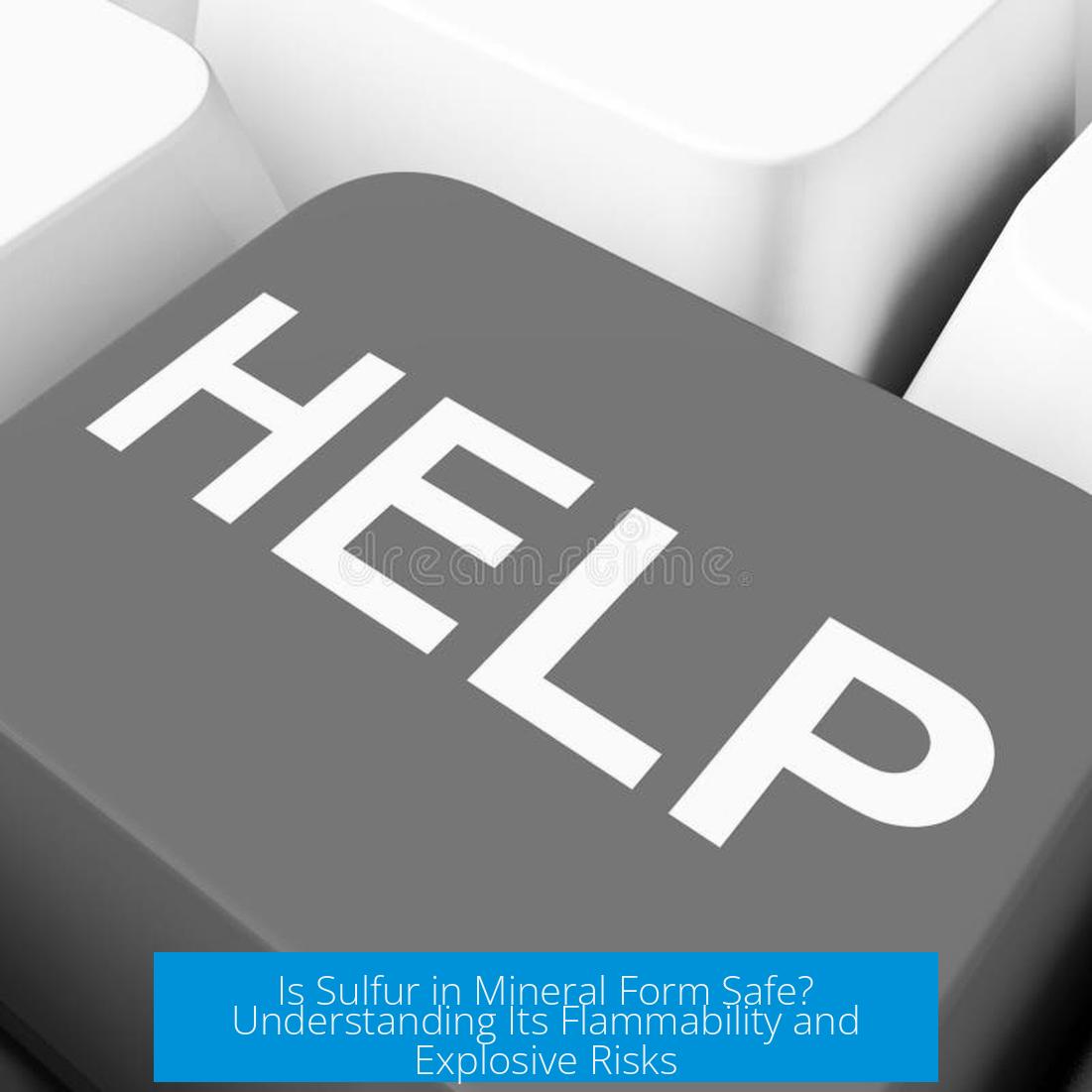Is Sulfur in Mineral Form Flammable or Explosive?

Sulfur in its mineral form is flammable but not explosive. It burns slowly with a low ignition temperature and melts before burning. While pure sulfur does not detonate or explode, it serves as a key component in explosive mixtures when combined with oxidizers, such as potassium nitrate, enabling energetic reactions like gunpowder combustion.
Understanding the Flammability of Sulfur Mineral

Sulfur found naturally as a mineral is indeed flammable. However, it is not easy to ignite. When it finally burns, it produces a characteristic blue flame, but the combustion is relatively slow and moderate in energy release.
- Sulfur melts at about 115 °C before it starts burning, turning into a liquid that can spread on surfaces.
- This melting property means pure sulfur cannot easily be shaped into solid burning projectiles, such as flaming arrows, because it would melt before ignition.
- Dipping materials like cloth into molten sulfur can make igniting easier, producing smoldering fire that erupts in blue flames upon ignition.
These properties reveal the limits sulfur has when considered by itself as a fuel for fire or ignition.

Behavior and Hazards of Burning Sulfur
When sulfur burns, it combines with oxygen to yield sulfur dioxide (SO2), a toxic gas. This makes burning sulfur an environmental and health hazard.

- The sulfur dioxide produced causes irritation of the eyes, respiratory tract, and can lead to acid rain formation through its conversion to sulfuric acid in the atmosphere.
- Thus, any use of burning sulfur requires caution to avoid inhalation or environmental damage.
Sulfur’s Role in Explosives and Gunpowder
Pure sulfur is not explosive. However, it performs a vital role in explosive mixtures when combined with other compounds.

Gunpowder Composition
| Component | Function | Effect in Reaction |
|---|---|---|
| Sulfur | Fuel and ignition aid | Burns at low temperature; helps fuel carbon; lowers ignition threshold |
| Charcoal (Carbon) | Main fuel | Oxidizes releasing heat |
| Potassium nitrate (Saltpetre) | Oxidizer | Releases oxygen to support combustion internally |
In gunpowder, sulfur oxidizes exothermically and allows the mixture to ignite easily at relatively low temperatures. It also enhances the energy output and stabilizes the burning sequence. Potassium nitrate supplies oxygen, removing the need for external air. This chemical environment creates rapid combustion that can generate pressure, causing explosive effects when confined.

Other Sulfur-based Explosive Compounds
Sulfur, when combined with chlorate or bromate salts and antimony sulfide or phosphorus sulfides, participates in mixtures that ignite on impact or under friction.
- Phosphorus sulfides and antimony sulfides mixed with oxidizers create match-head compounds.
- Mixtures of sulfur powder and potassium chlorate can explode upon impact due to rapid oxidation.
- Sulfur dust in air can cause dust explosions in confined spaces with enough ignition energy.
These reactions are sensitive and require precise conditions absent in pure sulfur mineral lumps.
Limitations of Using Pure Sulfur as a Fuel or Explosive
Pure sulfur’s practical use as a standalone explosive or fuel is markedly limited.
- Its low ignition temperature means it melts before burning, causing difficulty maintaining solid form for ignition.
- When exposed to air without confinement or an oxidizer, pure sulfur burns sluggishly rather than exploding.
- Flames tend to extinguish quickly if cooled or deprived of heat, making sulfur alone unsuitable for ballistic ignition like flaming arrows.
Thus, successful ignition or explosive behavior requires sulfur’s inclusion in a compound mixture with other reactive materials.
Practical Uses of Sulfur in Ignition and Pyrotechnics
Despite its limitations, sulfur finds usage in practical ignition applications:
- Dipping cloth or rag in molten sulfur and lighting it produces slow-burning fire sources used historically in fire arrows.
- Sulfur-based mixtures generate sulfur dioxide fumes which can be used for insect control, such as removing wasp nests.
- Historical incendiary mixtures like Greek Fire may have employed sulfur as part of a blend with naphtha and calcium oxide.
These methods exploit sulfur’s low ignition temperature and toxic fumes but do not rely on its explosive potential alone.
Nomenclature and Comparative Materials
The term “brimstone” refers to sulfur in historical texts, acknowledging its common natural form.
Phosphorus, an element related to sulfur, often serves as a better ignition agent or fuel due to different chemical properties that support more reliable combustion and ignition in mixtures.
Tannerite and other modern explosives use different chemistry, often combining metal powders and oxidizers, making them more energetic than sulfur-based mixtures.
Summary of Key Points
- Sulfur in mineral form is flammable but hard to ignite and burns slowly with a blue flame after melting.
- Pure sulfur is not explosive and cannot maintain combustion well without confinement or added oxidizers.
- It plays an essential role as a low-temperature fuel in gunpowder and incendiary mixtures, providing ignition aid and energy release.
- Compounds with sulfur and oxidizers (potassium nitrate, chlorates) can explode or ignite on impact.
- Sulfur combustion produces toxic sulfur dioxide gas, posing health and environmental risks.
- Practical uses involve sulfur-soaked materials or mixtures rather than pure sulfur mineral.
- Phosphorus and other chemicals sometimes replace sulfur for better ignition or explosive effects.
Help a Writer Out! Is Sulfur in Mineral Form Flammable or Explosive?
Here’s the quick take, straight from the lab and history books: Yes, sulfur in its natural mineral form is flammable, but it is not explosive on its own. It’s tricky to ignite, burns slowly with a characteristic blue flame, and melts before it really catches fire. So, if you pictured sulfur chunks lighting up like firecrackers, think again. It takes some help from chemicals like potassium nitrate to turn sulfur into something explosive.
Now, let’s unravel this elemental mystery with some juicy details, practical examples, and a sprinkle of historical context. After all, sulfur has been fascinating humans for thousands of years—sometimes as a firestarter, sometimes a weapon ingredient, and sometimes just a stinky mineral.
The Slow Burn: Understanding Sulfur’s Flammability
Sulfur is flammable but don’t expect it to go up in a spectacular blaze.
- It burns at a relatively low temperature and produces a blue flame. Not exactly what you’d call “fireworks.”
- Before burning, sulfur melts. This means you can’t just light a ball of pure sulfur and fling it like a flaming arrow. It would turn into a molten puddle first.
- Some people have experimented by dipping cloth in molten sulfur to create fire arrows that smolder and then burst into blue flames, producing a noxious smoke cloud on impact.
Imagine trying to start a campfire with sulfur rocks alone—good luck. Its ignition point is high enough to be a challenge but low enough to burn gently once started.
Sulfur and Explosives: The Chemical Team Player
While sulfur doesn’t shout, it whispers loudly when combined in explosives.
- Sulfur, charcoal, and saltpetre (potassium nitrate) form the classic gunpowder trio. Here, sulfur acts as the “fuel” that lowers the ignition temperature and fuels the reaction.
- Potassium nitrate decomposes to release oxygen inside the mixture, allowing gunpowder to burn even without air. This is why fireworks keep going even if you try to smother them.
- Sulfur’s role is less about ignition and more about sustaining and intensifying the reaction. It undergoes exothermic oxidation, releasing energy and making the whole thing more potent.
Turns out, sulfur is the quiet team player in fireworks and early explosives—not the solo pyrotechnic star. It relies on oxidizers like potassium nitrate or chlorates to shine.
Why Pure Sulfur Isn’t Your Go-To Explosive
Pure sulfur as a standalone explosive? Nope!
- It melts before it burns, which means it can’t hold shape as a projectile or explosive charge on its own.
- Solid sulfur or powders don’t combust well unless mixed intimately with an oxidizer.
- You’d get a flammable reaction but not anything resembling a controlled explosion.
Trying to ignite a chunk of sulfur won’t start a flamethrower effect. You’d get a brief flame followed by a slow burn. It’s flammable, yes, but not very impressive under normal conditions.
Classic and Curious Uses of Sulfur Combustion
Sulfur’s been put to some clever practical use in creative ignition methods.
- Dipping cloth in molten sulfur and lighting it creates smoldering fire arrows with blue flames and heavy sulfur dioxide smoke. This smoke is toxic enough to keep attackers or pests at bay.
- One adventurous soul cleared out wasp nests by rolling sulfur powder enclosed in a rag, soaked it with kerosene, and lit it on a stick. The resulting sulfur dioxide fumes drove the wasps away effectively.
These applications highlight sulfur’s potential when mixed or combined with other materials, not as the lone fire starter.
Beware the Toxic Trail: Burning Sulfur’s Dark Side
If you’re thinking of lighting up some sulfur for fun, hold on!
- Burning sulfur releases sulfur dioxide, a toxic gas that irritates lungs and eyes, and contributes to acid rain by forming sulfuric acid in the atmosphere.
- The fumes are no joke and can make a bystander feel like their lungs are under siege. Not ideal for casual backyard pyrotechnics.
So burning sulfur is not just about flames—it’s about facing some pretty unpleasant smoke. Less “pretty sparkles” and more “hold your breath.”
Sulfur’s Role in Ancient and Alternative Fire Mixtures
Fun fact: sulfur may have been part of the legendary “Greek Fire”—a fearsome incendiary weapon that ancient armies wielded.
- Greek Fire reportedly contained naphtha (a type of petrol), calcium oxide, and sulfur.
- Calcium oxide produces heat when it reacts with water, enough to ignite fuels. Coupled with sulfur, it made a sticky, hard-to-extinguish weapon.
So, sulfur’s not just a slow-burning mineral. It’s a key ingredient in ancient secrets, hinting at its more dynamic role mixed with other chemicals.
Comparing Sulfur to Other Substances for Ignition and Explosives
Looking beyond sulfur? Here’s how it stacks up:
- Phosphorus is often a better candidate for easy ignition or match heads.
- Explosives like Tannerite utilize aluminum nitrate and powdered aluminum—ingredients far more energetic in their reactions.
- Sulfur is more of a helper fuel in low-temperature exothermic reactions, not the main event.
In other words, if you want a flashy, explosive ingredient to steal the show, sulfur alone won’t cut it. It’s the supporting act in the chemical orchestra.
Final Thoughts: Using Sulfur in Fiction or Practical Scenarios
Writers and hobbyists, take note:
- Sulfur’s flammability is real but not dramatic on its own. You’ll need to combine it with oxidizing agents to get explosions or fiery effects worthy of an action scene.
- Fire arrows coated with sulfur-soaked cloth are plausible—expect blue flame and toxic smoke.
- Real explosions require confinement and careful chemical mixtures; sulfur alone just won’t deliver a bang.
- Always respect safety and avoid DIY explosive experiments. Sulfur’s combustion produces harmful fumes. Plus, explosive mixtures can be dangerous and illegal.
Sulfur’s a fascinating element sitting quietly at the crossroad of chemistry, history, and warfare. It may not be the explosive hero you expect, but its smokey blue flames and chemical contributions prove it’s a critical player in the story of fire and explosions.
So, dear writer, if your villain needs a fire-starting mineral, sulfur fits the bill. Just don’t count on it lighting up the room with a bang—unless potassium nitrate’s on the guest list!
Is sulfur in mineral form easy to ignite and burn?
Sulfur is flammable but hard to ignite. It burns slowly with a blue flame. It melts before it fully burns, making it tricky to light as a solid piece.
Can pure sulfur mineral cause explosions?
Pure sulfur by itself is not explosive. It only burns slowly and is not capable of causing powerful blasts without other chemicals.
How does sulfur contribute to gunpowder’s explosive reaction?
Sulfur acts as a low-temperature fuel in gunpowder. It lowers ignition temperature and releases energy, helping the mixture burn faster when combined with charcoal and saltpetre.
Are fire arrows made using pure sulfur mineral?
No, pure sulfur is not practical for fire arrows. Instead, cloth can be dipped in molten sulfur to create an ignitable material that burns with blue flames and toxic smoke upon impact.
Why is burning sulfur considered toxic?
Burning sulfur releases sulfur dioxide gas. This gas can irritate lungs and eyes because it forms sulfuric acid when mixed with moisture in the air.
Can sulfur powder cause dust explosions?
Yes, finely powdered sulfur can create dust explosions if mixed with the right oxidizers. Alone, it is not explosive but can be dangerous in dust form combined with other chemicals.





Leave a Comment